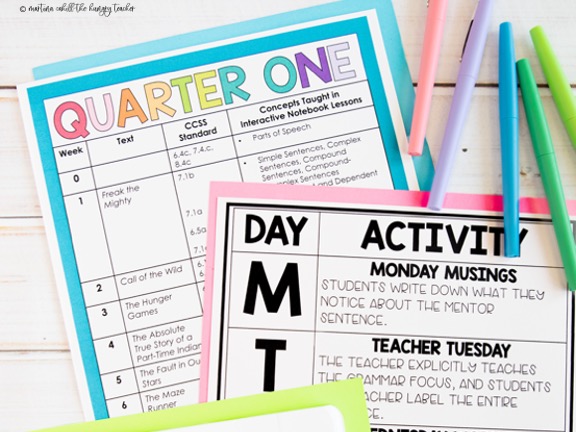hey friend!
I'm Martina.
I provide practical, time-saving strategies that actually work—so you can engage your students, teach effectively, and reclaim your time from the exhausting planning-grading cycle.
Browse Our ELA Resources
How to Use Mentor Sentences with Middle School Students
It’s likely you’ve heard of mentor sentences before. In fact, you may have tried to use them in your classroom or been to professional development where mentor sentences were suggested.
There is a lot of talk about the benefits of using mentor sentences…but how do you actually make them work in your classroom? And do you have to devote weeks of preparation before they become effective tools?
I have good news for you: mentor sentences can begin working for your students right away. Your middle schoolers don’t have to wait to reap the benefits. Let’s talk about how you can get started with mentor sentences.
Preparation and Planning
This may seem obvious, but if you want mentor sentences to benefit your students, you can’t create a sentence all willy-nilly. It’s going to take a little planning.
First, decide what you want your students to gain from the mentor sentence. Do you want students to master metaphors? Are you wanting students to use certain punctuation, such as semicolons? Write down a skill you want to focus on.
Next, I recommend taking a story or book you are currently reading or something you read recently in class. Begin to search the text for a sentence that addresses your skill. Make sure it is a good model for this skill. If you feel it is, then write that sentence down!
Lastly, come up with a daily plan. The good news is that you only need one mentor sentence each week. Throughout the week, you will examine different aspects of the sentence. Create a daily plan that you can repeat each week. These can be as interactive or independent as you want! Here’s a few ideas to get you started:
- Explicitly teach a grammar skill using the mentor sentence
- Have students create their own sentence with the mentor as a guide
- Enhance the mentor sentence
- Identify the elements students already know (punctuation, grammar, parts of speech)
P.S. Want access to my weekly plan PLUS two weeks of mentor sentences? Grab the freebie here! I also have a quarterly and yearly bundle of mentor sentences, so you are never stuck searching for lists of mentor sentences again. You can grab those mentor sentence packs here.

Getting Started from Day One
You have a mentor sentence chosen for your first week, and you know what activity students will engage in with the model sentences. Now, how do you start? Just jump right in?
The short answer: yes! You want to display the sentence somewhere visible in the classroom, such as the board or screen. You can even print out the sentence on slips of paper for students to use, or just have them copy the sentence into their journal.
Now, here is where the real magic comes in. On day one, it’s likely you will have students doing some type of observation or identification with the sentence, such as, “Look at the sentence on the board. Write down anything you notice.”
You will have students that say, “What do you mean by that? I didn’t notice anything.” This might make you think mentor sentences aren’t going to work, but that’s not the case. You are going to be prepared by having a reference sheet for students!
I call these reference sheets, but truly, they can take many forms. They may be anchor charts, notes, mini-booklets, or any sort of written document that provides students with information. You are going to direct students to look there for information.

Let’s look at an example.
On the board, you have the following sentence: When the circus comes into town, the entire city turns into a flock of birds migrating towards its captivating presence.
You ask students to notice what they see. Students turn to their notes. They have notes on the types of sentences, so they label the sentence as complex and notes on figurative language, so they note that “the entire city turns into a flock of birds” is a metaphor. They also have notes on commas, so they note that the first comma comes after a dependent clause.
Identifying these elements without notes is possible, but for many students, it can feel impossible. The reference pages give students a starting place for identifying and displaying their knowledge.
Reference pages make jumping into mentor sentences possible. Let’s face it – grammar, sentence structure, punctuation – it’s a lot for our students to keep up with. Reference pages keep you from reteaching and instead help you keep reinforcing and spiraling while using mentor sentences. This will make using mentor sentences an effective tool that moves your students forward, from day one!
If you don’t have a place for students to go to reference past concepts, you should take a look at my different reference notes resources! I have one-pagers, booklets, and cards! All of these address sixty-two essential grammar and language skills, and makes it easy for students to review past material.

Want a sneak peek at teaching The Hungry Teacher way—with support, structure, and strategy?
When you join the waitlist for The Hungry Teacher’s Hub membership, you get three free classroom-ready resources: a theme unit, an expository writing unit, and a grammar unit introducing mentor sentences. Plus, you’ll get immediate access to a selection of exclusives from the Hub, including editable sub plans, pacing guides, and more.
No strings attached. Just resources you can use right now—and a heads-up when the Hub opens.
3 Free Middle School ELA Units—yours to keep!
JOIN THE WAITLIST + A FREE GIFT
Where to next, line leader?
Welcome to The Hungry Teacher! We create resources that are easy to use, practical, and get results. Teach with confidence—and make it home before dinner.
xo, the hungry teacher